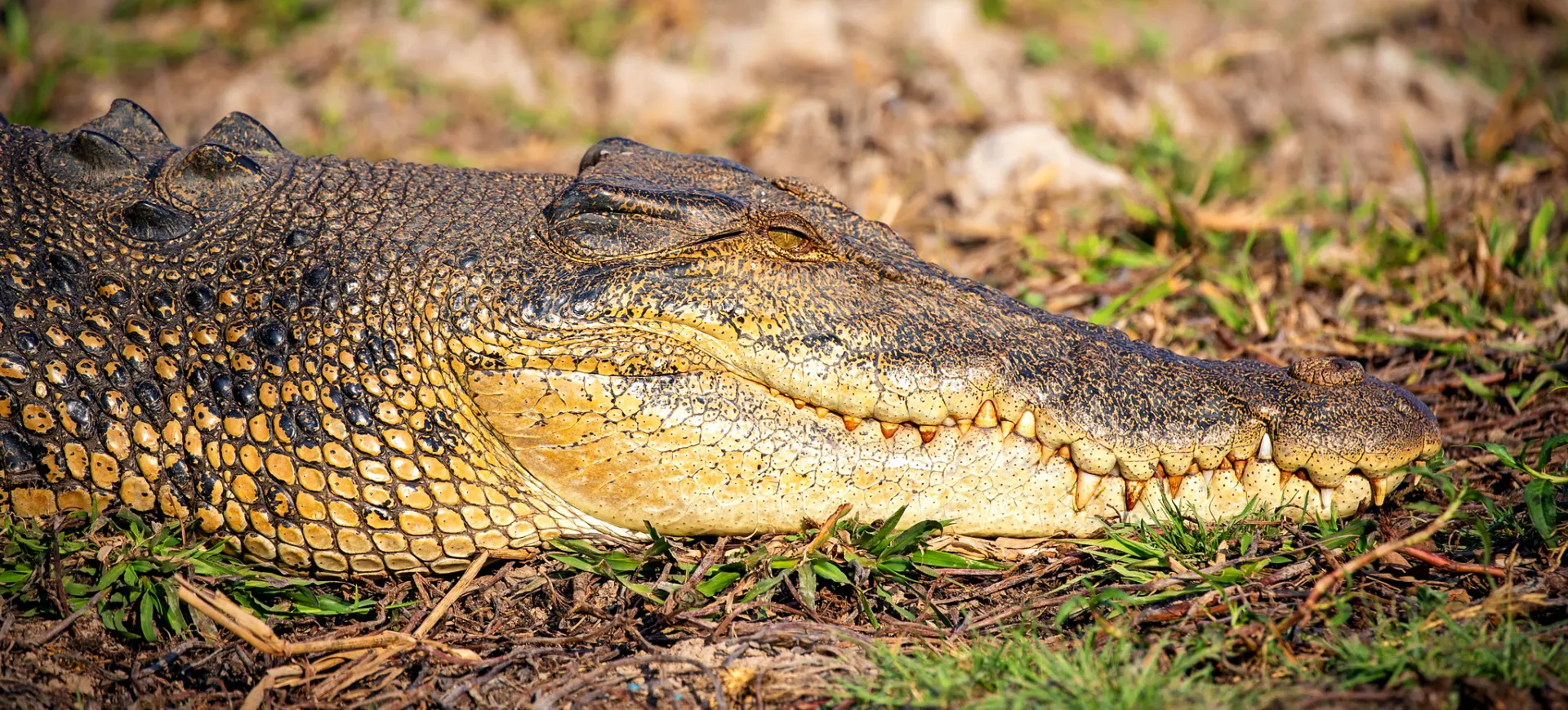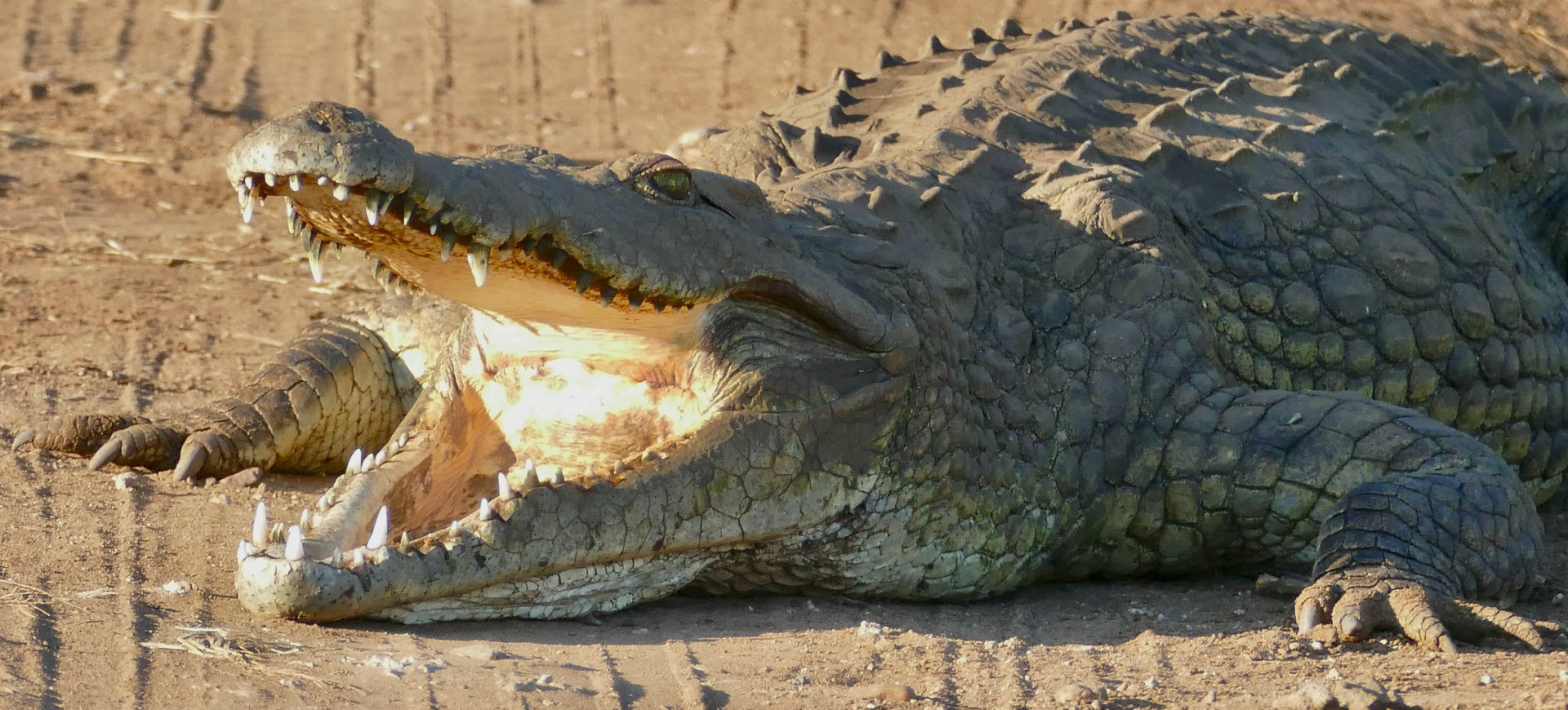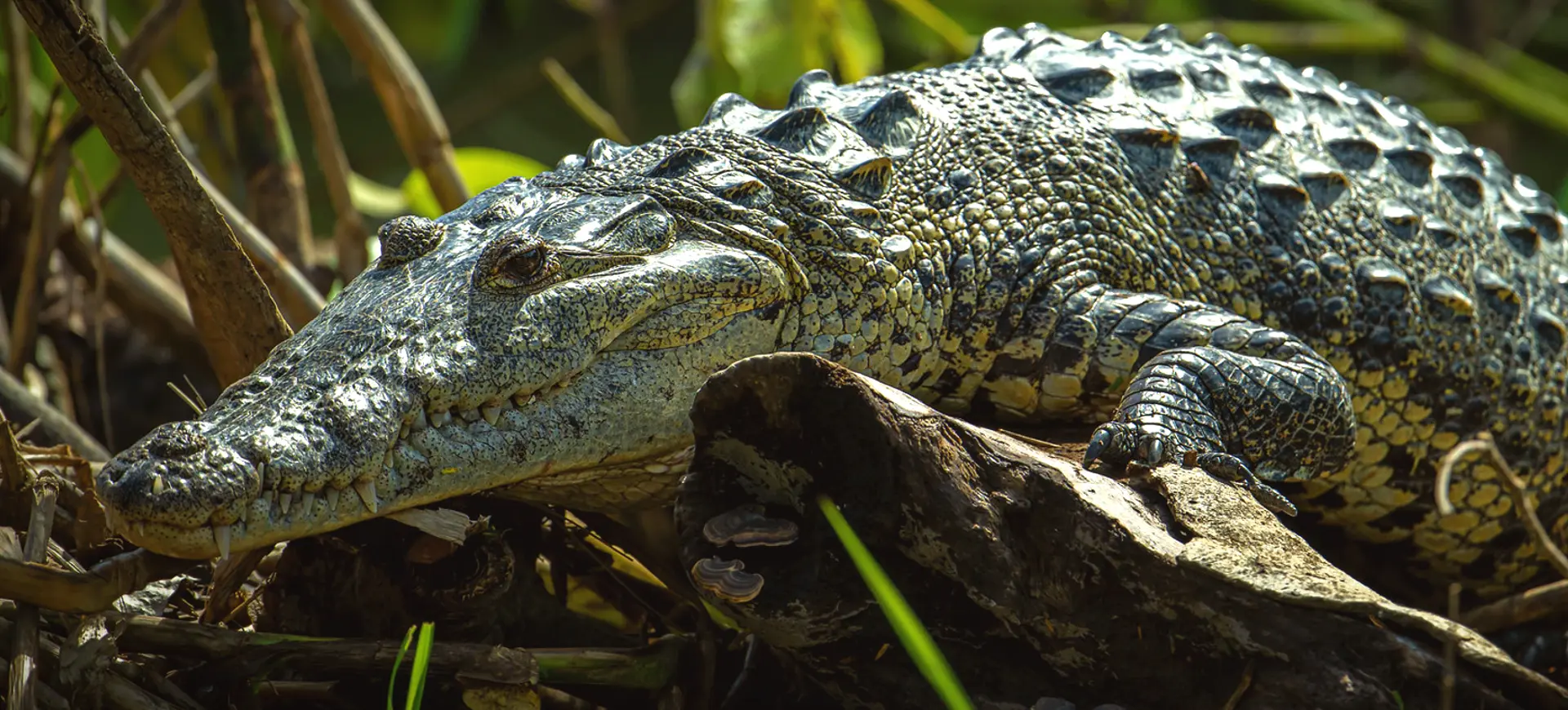Overview
The African Dwarf Crocodile (Osteolaemus tetraspis), also known as the Dwarf Crocodile, is the smallest crocodile species found predominantly in the dense rainforests of Central and West Africa. Characterized by its short snout and armored skin, this nocturnal reptile typically grows to about 5 feet in length, showcasing a dark, often black, coloration that aids camouflage within its murky aquatic habitats. Despite its smaller size than other crocodilian species, the African Dwarf Crocodile possesses a robust and stocky body, with powerful jaws and sharp teeth designed for a predatory lifestyle. These creatures are solitary and elusive, spending much of their time in slow-moving rivers, swamps, and mangrove forests, where they adeptly navigate and hunt within the water and on land during the night.
The species plays a critical role in maintaining the ecological balance within its habitat, acting as both predator and prey within its ecosystem. The African Dwarf Crocodile’s diet primarily consists of fish, amphibians, crustaceans, and occasionally small mammals, reflecting its opportunistic feeding habits. Despite its fearsome appearance and predatory nature, this crocodile is known for its relatively docile demeanor towards humans. However, it remains a wild animal that can exhibit aggression when threatened or provoked. Conservation efforts are underway to protect the African Dwarf Crocodile, as habitat destruction and hunting for bushmeat and traditional medicine pose significant threats to its survival. These efforts include habitat preservation, legal protection, and community engagement programs to reduce human-crocodile conflicts and promote sustainable coexistence.
The African Dwarf Crocodile exhibits notable reproductive behaviors, with females constructing mound nests near water bodies where they lay their eggs. The maternal care exhibited by these crocodiles is remarkable, with females guarding the nests vigilantly and assisting the hatchlings to water upon emergence. This level of parental investment ensures a higher survival rate for the offspring, highlighting the species’ adaptation to its environment. The African Dwarf Crocodile’s lifecycle, behavior, and conservation status offer valuable insights into the challenges and opportunities for conserving biodiversity in Africa’s tropical forests.
Taxonomy
Kingdom
Phylum
Class
Order
Family
Genus
Species
Type
Current distribution:
The African Dwarf Crocodile is distributed across various countries in Central and West Africa, with populations found in areas such as Angola and the Democratic Republic of Congo, Ghana, Nigeria, and parts of West Africa. This broad distribution indicates the species' adaptability to different freshwater habitats within the tropical rainforest belt. Despite this wide range, the African Dwarf Crocodile faces habitat loss and hunting challenges, which have led to localized declines in some areas. Conservation measures, including habitat protection and anti-poaching efforts, are vital to ensuring the species' long-term survival across its natural range.
The presence of the African Dwarf Crocodile in protected areas and national parks contributes to its conservation, providing sanctuaries where the species can live with reduced human interference. Monitoring and research efforts within these protected areas help gather crucial data on population trends, habitat preferences, and threats, informing conservation strategies and actions to preserve the species and its environment.
Physical Description:
The African Dwarf Crocodile is distinguished by its armored, darkly pigmented skin, which provides effective camouflage in its natural habitat. This crocodile species exhibits a more compact and stocky body structure than its larger relatives, with a notably short and broad snout differentiating it from other crocodiles. Adult individuals typically exhibit a dark green to black coloration, with a slightly lighter underside, and their bodies are covered in bony plates called osteoderms, which offer protection against predators and environmental hazards. The eyes and nostrils of the African Dwarf Crocodile are positioned on top of the head, allowing it to see and breathe while submerged, a feature that is particularly useful for an ambush predator.
Despite being the smallest species of crocodile, the African Dwarf Crocodile possesses considerable strength, with powerful limbs that enable it to navigate both aquatic and terrestrial environments effectively. Its tail is muscular and flattened on the sides, aiding in propulsion through water. The jaws of the African Dwarf Crocodile are equipped with numerous conical teeth suited for gripping slippery prey such as fish and amphibians. With its stealth and patience, this physical adaptation makes the African Dwarf Crocodile an effective predator within its habitat.

Lifespan: Wild: ~40 years || Captivity: ~50 years

Weight: Male: 40-71 lbs (18-32 kg) || Female: 40-71 lbs (18-32 kg)

Length: Male & Female: 59-70 in (150-180 cm)
Characteristic:
Native Habitat:
The African Dwarf Crocodile is native to the dense rainforests and wetlands of Central and West Africa, inhabiting various freshwater environments. This includes slow-moving rivers, swamps, and mangrove forests, areas with dense vegetation cover and water access necessary for the crocodile’s survival. The species’ preference for murky, vegetated waters allows it to remain concealed from prey and potential predators, a key aspect of its behavior and survival strategy. The habitat of the African Dwarf Crocodile also offers ample opportunities for nesting and basking, essential activities for its thermoregulation and reproductive success.
Conservation of these natural habitats is crucial for the continued survival of the African Dwarf Crocodile. Deforestation, pollution, and habitat fragmentation threaten these environments, impacting the crocodile’s food availability and nesting sites. Efforts to preserve and restore these critical habitats are essential for protecting the species and the overall biodiversity of the regions they inhabit.
Climate Zones:
Biomes:
Biogeographical Realms:
Continents:
Countries:
Diet:
Diet & Feeding Habits:
The African Dwarf Crocodile is an opportunistic predator with a diet primarily consisting of fish, amphibians, crustaceans, and occasionally small mammals and birds. This dietary flexibility allows it to thrive in various aquatic environments, from clear streams to murky swamps. The crocodile’s hunting strategy involves waiting for unsuspecting prey to come within striking distance before launching a swift attack, utilizing its powerful jaws to capture and consume its catch. This method of hunting highlights the crocodile’s role as a key predator within its ecosystem, contributing to the regulation of prey populations and the maintenance of ecological balance.
Feeding behavior in the African Dwarf Crocodile varies depending on the availability of food sources in its habitat. During the dry season, when water levels are lower, and prey is more concentrated, the crocodile may have more opportunities to feed. Conversely, when prey is more dispersed in the wet season, it may need more energy to locate food. This adaptability in feeding habits underscores the crocodile’s ability to survive in the fluctuating conditions of its tropical environment.
Mating Behavior:
Mating Description:
The African Dwarf Crocodile exhibits unique reproductive behaviors, with a breeding season typically during the rainy season when water levels are high. Females construct nest mounds out of vegetation and mud near water bodies, where they lay their eggs and cover them to incubate naturally. The nest’s temperature can influence the sex of the hatchlings, a phenomenon known as temperature-dependent sex determination. Female crocodiles exhibit high maternal care, guarding the nest from predators and assisting the hatchlings to the water upon emergence.
Hatchlings are relatively independent from birth but may stay close to their mother for protection and guidance during their early life. This parental investment increases the chances of survival for the offspring in the wild, where they face numerous threats from predators and environmental challenges. The social structure of the African Dwarf Crocodile during the breeding season is centered around these family units, with mothers displaying protective behaviors towards their young. This period is critical for reinforcing social bonds and transmitting survival skills from mother to offspring.
Reproduction Season:
Birth Type:
Pregnancy Duration:
Female Name:
Male Name:
Baby Name:
Social Structure Description:
The African Dwarf Crocodile is generally solitary, with individuals exhibiting territorial behavior, especially males. These crocodiles defend against intruders with specific home ranges, using visual displays and vocalizations to communicate their presence and dominance. Social interactions increase during breeding when males and females come together for mating. After mating, females focus on nesting and parental care, demonstrating a temporary shift towards more social behavior as they protect their nests and young.
The social structure of the African Dwarf Crocodile is adapted to its nocturnal and elusive lifestyle, with individuals relying on stealth and camouflage to avoid detection by both prey and predators. Understanding the social dynamics of this species is important for conservation efforts, as it influences habitat requirements, breeding success, and interactions with humans and other wildlife.
Groups:
Conservation Status:
Population Trend:
The African Dwarf Crocodile is currently classified as Vulnerable by the IUCN, with a population trend generally decreasing. The primary factors contributing to this decline include habitat destruction due to logging, agriculture, human settlement expansion, hunting for meat, and traditional medicine. These activities reduce the available habitat for the crocodiles and directly decrease their numbers. Efforts to accurately assess the population size and distribution of the African Dwarf Crocodile are complicated by its elusive nature and the remote, dense habitats it occupies.
Conservation initiatives to protect the African Dwarf Crocodile focus on habitat preservation, anti-poaching measures, and community engagement to reduce human-wildlife conflict. Education and awareness programs are also important tools for promoting coexistence and highlighting the ecological importance of crocodiles. Protected areas and wildlife reserves offer crucial refuges for these crocodiles, allowing for the conservation of the species and the ecosystems they inhabit.
Population Threats:
The main threats to the African Dwarf Crocodile include habitat destruction through deforestation, pollution, and the expansion of agricultural and urban areas. These activities lead to the fragmentation and loss of the crocodile’s natural habitats, reducing the availability of suitable nesting and feeding sites. In addition to habitat threats, hunting for bushmeat and traditional medicine poses a significant risk to the species, with local populations being heavily impacted in some areas. The illegal pet trade also contributes to the decline of wild populations, as individuals are removed from their natural environment.
Climate change presents a long-term threat to the African Dwarf Crocodile by altering the ecosystems it depends on. Changes in rainfall patterns, temperature, and water availability can impact the species’ breeding, feeding, and survival. Addressing these threats requires a multifaceted approach that includes habitat protection, legal enforcement against hunting and trade, and initiatives to mitigate the impacts of climate change.
Conservation Efforts:
Conservation efforts for the African Dwarf Crocodile include legal protection under national and international laws, habitat conservation and restoration, and community-based conservation programs. These efforts aim to address the key threats to the species by preserving critical habitats, reducing hunting and trade, and engaging local communities in conservation activities. Research and monitoring are also essential components of conservation strategies, providing data on population trends, habitat requirements, and the effectiveness of conservation measures.
Collaboration between governments, conservation organizations, and local communities is crucial for successfully conserving the African Dwarf Crocodile. Initiatives that provide alternative livelihoods and promote sustainable use of natural resources can help reduce pressure on crocodile populations and their habitats. Education and awareness campaigns are important for raising public understanding of the species’ ecological role and the need for its conservation.
Additional Resources:
Fun Facts
- The African Dwarf Crocodile is the smallest crocodile species in the world.
- They can hold their breath underwater for up to 15 minutes while hunting or hiding.
- Unlike other crocodile species, the African Dwarf Crocodile often climbs into low branches to bask in the sun.
- Their armored skin comprises hard scales called osteoderms, which act as natural armor.
- The sex of the hatchlings is determined by the temperature of the nest where the eggs are incubated.
- African Dwarf Crocodiles have a relatively long lifespan, living up to 50 years in captivity.
- They are known to use burrows and caves along riverbanks for shelter during the day.
- Despite their small size, they have a powerful bite and should be treated cautiously in the wild.
- The species is considered a living fossil, having changed little in millions of years.
- Conservation programs for the African Dwarf Crocodile often focus on community involvement and sustainable practices to protect these ancient reptiles.











